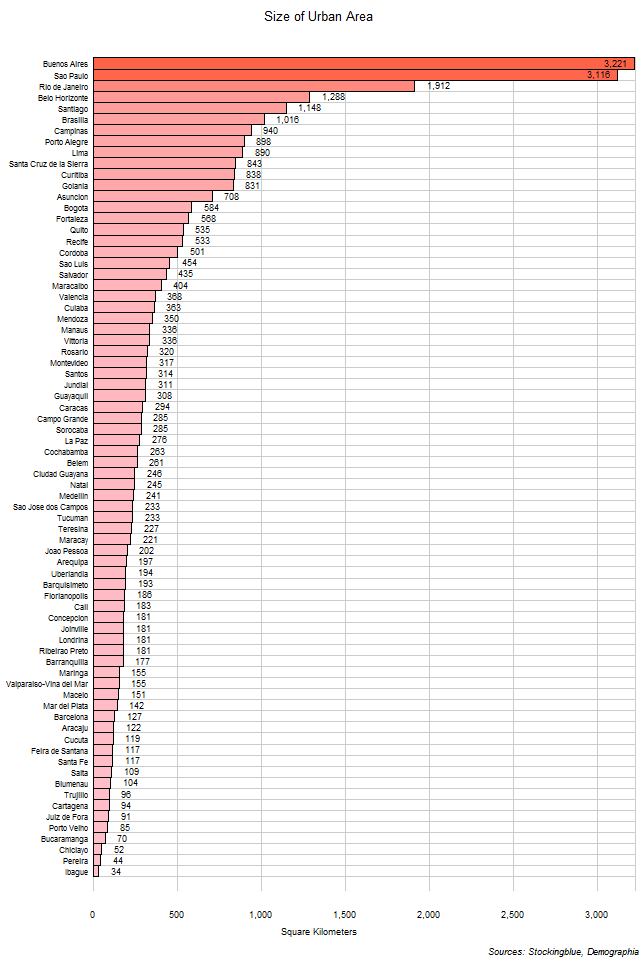
The chart above shows the urban area of each city with a population of over one million. The urban area has been normalized so as to avoid any inconsistencies with how cities and their metropolitan areas are defined by their governments. Each urban area has similar characteristics making this the definitive method with which to compare cities across various countries. All urban areas over 1,000 square kilometers in South America belong to either Brazil, Argentina, or Chile.
Findings
- The difference between the urban area with the greatest size, Buenos Aires, and the urban area with the least, Ibague, is 3,187 square kilometers (1,230.51 square miles).
- Buenos Aires has 94.74 times the urban area that Ibague does.
- The median size of urban area with a minimum population of one million in South America is 253.50 square kilometers (97.88 square miles) and the mean 436.97 square kilometers (168.72 square miles).
Caveats
- Data is from 2020.
- The methodology for how these urban areas have been defined can be found in the source link below. As of this writing this is the most reliable way to compare urban areas throughout the world.
- Some of these urban areas span several states, and the state that is being used here is the one where the core of the urban area is located. For instance, Milan's urban area spans both Italy and Switzerland, but since the core of the urban area is in Italy it would be listed as an Italian urban area and not a Swiss one.
- All figures are rounded to the nearest whole.
Details
Only 10 of the 15 South American states have urban areas with at least one million people. Of these, the Brazil has 36; Colombia has nine; Argentina has eight; Venezuela has seven; Peru has four; Chile and Bolivia each have three; Ecuador has two; and Paraguay and Uruguay each have one.
Buenos Aires makes up just under one-tenth of the total area of South American urban areas with over one million inhabitants at 9.96%. It, along with Sao Paulo make up just under one-fifth of the total area of South American urban areas with over one million inhabitants at 19.60%. Adding in Rio de Janeiro brings it up to over one-quarter at 25.51%.
All but two of the six urban areas with a population of over one million people that have an urban area of over 1,000 square kilometers are located in Brazil, one is in Argentina and one in Chile. All but four of the eight urban areas with a population of over one million people that have an area less than 100 square kilometers are located in Colombia, Peru and Brazil each have two.
Brazil has the largest area covered by its urban areas of over one million people with a total of 6,940 square kilometers (2,679.55 square miles) distributed among its 36 urban areas. Argentina has the second largest area covered by its urban areas of over one million people with a total of 1,928 square kilometers (744.41 square miles) distributed among its 8 urban areas.
The Falkland Islands (Malvinas), French Guiana, Guyana, South Georgia and the South Sandwich Islands, and Suriname do not have any urban areas with a population of over one million inhabitants.
Sources
Demographia. 2021. "Demographia World Urban Areas: 16th Annual Edition." Accessed March 9, 2021. http://demographia.com/db-worldua.pdf.